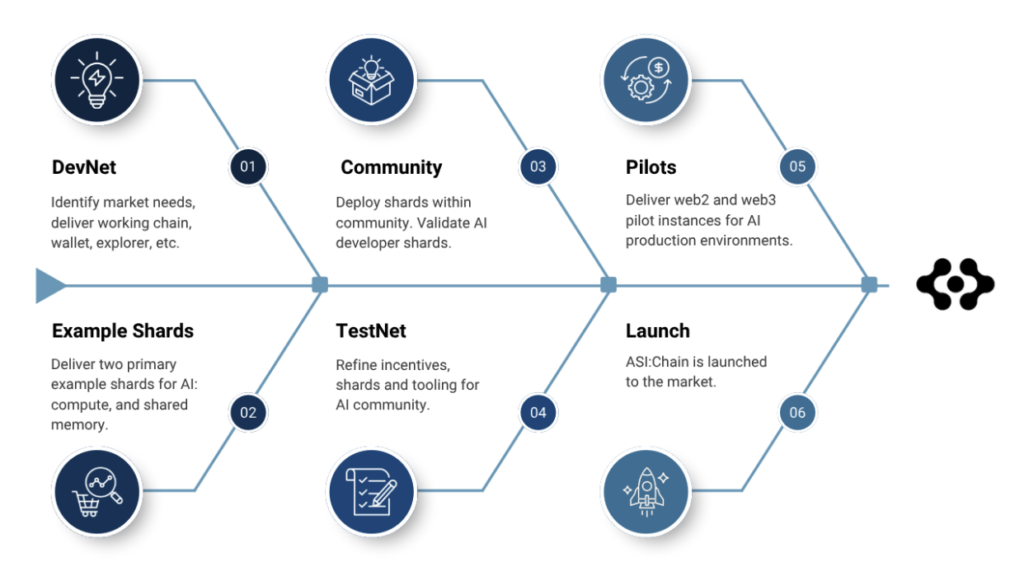Every blockchain starts with a bold premise.
ASI:Chain starts with a question: what if a blockchain could natively support distributed intelligence, not just passive computation?
What if, instead of bolting AI onto existing platforms, we started from scratch and built a foundation optimized for reasoning, autonomy, and evolution?
What if you had a blockchain that delivered everything you’d expect from a high-performance chain (speed, security, and formal logic) but also gave you the tools to build systems that think? Not just moving assets, but coordinating reasoning, learning, and autonomy at scale.
That foundation is ASI:Chain.
The Purpose of the DevNet
The ASI Chain DevNet offers a preview of what will soon evolve into the full TestNet for ASI Chain. It exists to give blockchain developers, smart contract engineers, and node operators direct access to early network capabilities. Instead of theory, builders can explore real chain behavior and gain practical familiarity with architecture, tools, and on chain execution. This hands-on access shortens the learning curve, builds confidence, and ensures that when TestNet opens, the developer community is already fluent and ready to build.
The ASI:Chain DevNet is currently a closed beta. This is a selective entry point for developers who want to help shape the direction of a fundamentally different blockchain. Those accepted into the DevNet will be the first to test the tools, validate the consensus, and write contracts in a system where intelligence and infrastructure meet.
The public DevNet will follow shortly, and we’ll be sharing more information soon about onboarding a broader group of developers.
If you’re a developer or node operator interested in joining the ASI:Chain DevNet, you can express your interest here.
ASI:Chain – The First True AI-Native Chain
ASI:Chain is designed to excel at everything a modern blockchain must deliver. Speed, scalability, security, and economic precision. But it also goes further. It’s built to support the next frontier: intelligent computation. Whether you’re running DeFi protocols, coordinating supply chains, or deploying autonomous agents, ASI:Chain provides a foundation strong enough for today’s demands and flexible enough for tomorrow’s breakthroughs.
The ASI:Chain architecture is built around shards. Each shard can have its own configuration, its own consensus mechanism, its own performance profile.
Different domains require different foundations. A shard handling low-latency trading will be tuned for speed. A shard managing mesh-networked IoT devices will favor robustness and fault tolerance. A shard focused on knowledge evolution might prioritize consistency and verifiability over throughput.
This is why ASI:Chain allows for differentiated consensus. The initial DevNet shard uses CBC Casper; a correct-by-construction consensus algorithm ideal for systems requiring provable fault tolerance. Future shards may adopt other consensus protocols such as Cassanova for high-speed operations or Cordial Miners for edge computing.
Each shard is autonomous but interoperable, giving developers unprecedented flexibility and precision. And eventually, anyone will be able to spin up their own shard, participate in network economics, and contribute to a global ecosystem of intelligent agents.
DevNet Ecosystem Overview: How Components Interact
The DevNet environment simulates a functioning blockchain ecosystem. It includes blockchain nodes, observer nodes, a web wallet, block explorer, faucet, and indexing layer. Developers and users connect through client applications and wallets, while validators and node operators anchor network execution. The architecture mirrors the full chain vision, which means every interaction builds familiarity for what will come at scale.
Applications can submit transactions, deploy smart contracts, and explore state changes. Observers monitor chain activity. Validators execute blocks. Indexers connect the raw chain ledger to readable interfaces. This creates a living sandbox where integration, testing, and learning unfold within a unified environment.
Smart Contracts That Evolve
In the DevNet, smart contracts can be written in Rholang or MeTTa-derived languages; both purpose-built for concurrency and expressive enough to support agentic logic. These are not adaptations of legacy systems. These languages were chosen because they fit the structure of the network itself: concurrent, composable, and capable of reasoning.
Under the hood, ASI:Chain includes a transactional knowledge store and query model that enables not just contract execution, but contract cognition. Contracts can be written to adapt based on data inputs, negotiate access through capabilities, and interact directly with one another without going through brittle middleware.
Developers participating in the DevNet will have direct visibility into validator behavior and consensus mechanics. They’ll also be the first to experiment with the tools that will shape the testnets and mainnet to follow.
Roadmap

DevNet
Status: In progress
- Cross-Platform Optimization: Ensures responsive wallet and explorer UX across all devices.
- Simplified Shard Deployment: One-click setup with built-in faucet, wallet, and explorer tools.
- BIP-39 Mnemonics: Secure recovery using industry-standard seed phrases.
- Third-Party Audits & Pen Testing: Comprehensive code and system security verification.
- Stress & TPS Testing: Evaluates reliability and performance under real workload conditions.
Initial Example Shards
- Compute Shard: The preliminary compute shard integrates ASI:Cloud to enable decentralized AI compute rental and payments through ASI:Chain.
- AI Compute Deployment: Deploy GPU/CPU workloads directly from shard nodes using pre-configured AI VM templates.
- Smart Contracts for Compute: Automate compute rentals, reservations, and resource tracking via on-chain contracts.
- Resource Monitoring: Real-time APIs for tracking usage, cost, and SLA compliance.
- Cross-Chain Interoperability: Handle compute and payment requests across Ethereum, Polygon, and Cosmos via ASI:Cloud.
- Shared Memory Shard: A Shared Memory Shard (SMS) is a high-performance environment that enables multiple nodes or processes to access a common memory pool, ideal for AI workloads, decentralized compute, and real-time data sharing.
- Global Memory Pool: Unified, dynamically allocated memory accessible to all nodes.
- Concurrency & Safety: Thread-safe operations via locks or atomics.
- Memory Isolation: Strict access control per process/application.
- Low-Latency Sharing: High-speed inter-process communication for parallelism.
- Effective Caching: Shared cache with efficient invalidation.
- Memory Compression: Real-time compression for better resource use.
- Horizontal Scaling: Add nodes dynamically without disruption.
- Distributed Shared Memory: Extend memory across servers.
- Dynamic Resource Balancing: Allocate based on workload demand.
Community
A strategic plan to drive awareness, adoption, engagement, and governance for the AI-focused compute shard built on ASI:Cloud combining community-driven growth, developer empowerment, and decentralized governance.
A. Awareness
Differentiators:
- Cost-efficient vs. centralized cloud
- Solves blockchain trilemma via efficient infrastructure and option for per-shard custom consensus
- Allows complex AI operations to be run on-chain, and flexibly toggled to run off/on chain depending on requirements
- Supports large-scale decentralized AI agent systems running diverse AI algorithms
- Hyper-efficient large-scale file and knowledge processing (leveraging MORK metagraph-database infrastructure that outperforms commercial graph DBs on key metrics)
- Cross-chain crypto payments (Cosmos & Ethereum)
- Renewable-powered, decentralized infrastructure
Activities:
- Focus groups with AI developers for pre-launch feedback.
- Partnerships with AI communities
- Webinars, AMAs, and AI/Web3 conference showcases.
- Blogs, tutorials, videos, and SEO content comparing shard performance to AWS/GCP.
- Social media campaigns and community use-case storytelling.
B. Adoption
Onboarding:
- Wallet login.
- Top-up via crypto tokens.
- Deploy pre-configured AI VMs in minutes.
Developer Resources:
- Step-by-step documentation and video tutorials
- Free trial & faucet for early exploration.
Incentives:
- Discounts & rewards for long-term users.
- Referral programs with compute-credit bonuses.
C. Governance
Purpose: Let users govern shard operations, treasury, and roadmap.
Example DAO Model:
- Quadratic & Reputation-Based Voting: Balance influence and reward contributions.
- Smart Contracts: Manage proposals, treasury, and token issuance.
- Transparent Audits: Public reports for accountability.
Progressive Decentralization:
- Core Team Council
- Community Voting
- Full DAO control.
Incentives for Participation:
- Governance token rewards, staking, and gamified leaderboards.
- Reputation systems and badges for active contributors.
DEX Integration:
- DAO revenue sharing from trading fees.
- DAO-driven feature and listing decisions.
D. Engagement
Community Building:
- Developer forums, Discord channels, and open discussions.
- Hackathons for AI use cases, with sustainability and efficiency categories.
Open-Source Ecosystem:
- Publish APIs, tools, and templates with rewards for contributions.
Recognition & Rewards:
- Leaderboards, NFTs, badges, and credits for major contributors.
E. Growth
- Continuous Feedback: Regular focus groups to refine features and performance.
- Infrastructure Expansion: More global data centers to reduce latency.
- Partnerships: Collaborate with AI labs, startups, and enterprises.
- Sustainability Commitment: Promote renewable-powered compute and eco-friendly development.
TestNet
Node Features
- Integrated Logging & Monitoring: Built-in tools for debugging, performance tracking, and network health insights.
- Optimized Deployment:
- RUST-based performance upgrades with memory improvements.
- Enhanced default configurations (better node peering, documentation).
- Kubernetes-ready containers for streamlined deployment and scaling.
Wallet Features
- UX & Accessibility
- Responsive Design—optimized for mobile and desktop on leading browsers.
- Browser Extension—expanded ASI Wallet extension linked to ASI Chain, with staking and NFT support.
- Payment Capabilities
- Fiat On/Off Ramps for easy conversion between crypto and traditional currency.
- MPC (Multi-Party Computation) wallets for Web2-compatible security.
- Evaluation of AI-driven payments and stablecoin integration for real-world testing.
- Staking
- Flexible Options: Single-asset, pooled, and liquid staking systems.
- Dynamic Rewards: Variable APR, compounded returns, and bonus rewards for early or long-term users.
- DeFi Integration: Use staking derivatives (e.g., ASI-LST) in lending or liquidity pools.
- Governance Participation: Weighted voting rights for long-term stakers and high-volume contributors.
- MPC/Hardware Wallet
- Recovery & Backup: Social recovery, encrypted seeds, and participant replacement options.
- Cross-Platform Compatibility: Works with mobile, desktop, hardware wallets, and multi-chain assets.
- Developer Integrations: APIs, SDKs, and debug tools for wallet extensions or dApps.
Pilots
- Deploy example shards in web2 environments with success metrics.
Launch
- Extend APIs, refactor TestNet and refine features according to community and pilot feedback.
Getting Started with the ASI:Chain DevNet
Over the coming phases, ASI:Chain will transition from this closed beta to an open public DevNet, followed by staged testnets and, ultimately, a mainnet designed to support scalable, intelligent computation.
Each phase will add functionality, tooling, integrations, and economic incentives.
But the direction is already clear: ASI:Chain is here to not only outperform existing chains, but also define what the next generation of decentralized systems should look like.
If you’re a developer who builds systems that think, a researcher working on autonomous computation, or a founder exploring the edge of decentralized infrastructure, the DevNet is your opportunity to help shape something foundational.
Apply to join the ASI:Chain DevNet here. If you have any questions, feel free to join the Artificial Superintelligence (ASI) Alliance developer forum.
Let’s build the infrastructure for the age of intelligence.

